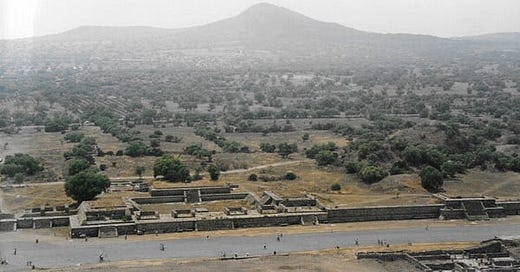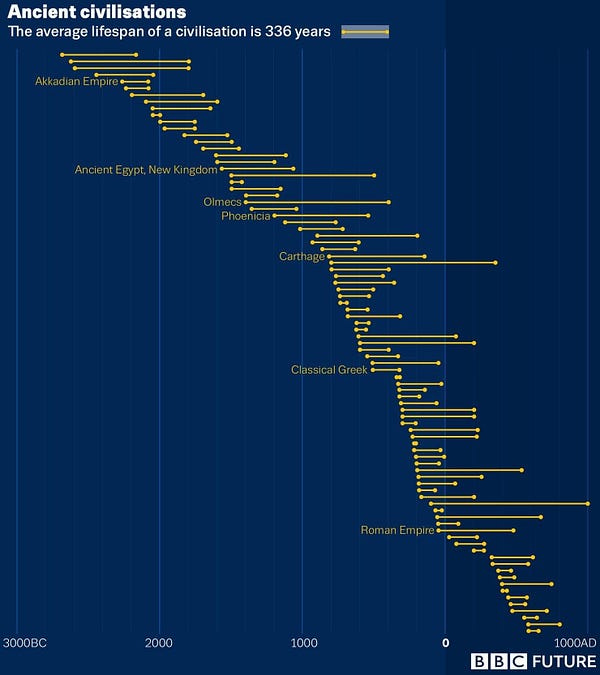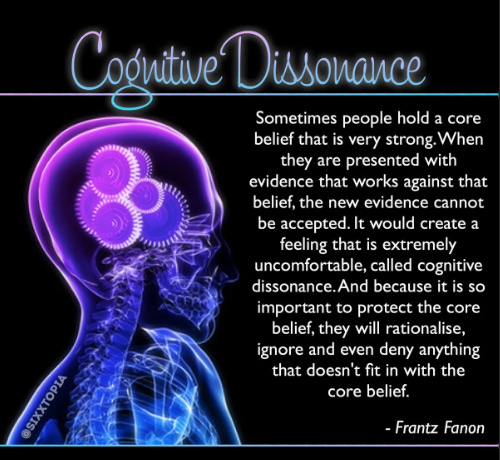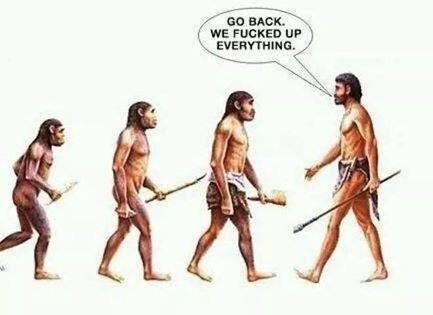March 6, 2023 (original posting date)
That Uncertain Road, Part 2
The set of possible futures includes a great variety of paths. There may be abrupt collapse; it is also possible there may be a smooth transition to sustainability. But the possible futures do not include indefinite growth in physical throughputs. This is not an option on a finite planet. The only real choices are to bring the throughputs that support human activities down to sustainable levels through human choice, human technology, and human organization, or to let nature force the decision through lack of food, energy, or materials, or through an increasingly unhealthy environment.
- Donella Meadows, Jorgen Randers, Dennis Meadows (2002) Limits to Growth: The 30-Year UpdateHowever much we like to think of ourselves as something special in world history, in fact industrial societies are subject to the same principles that caused earlier societies to collapse. If civilization collapses again, it will be from failure to take advantage of the current reprieve, a reprieve both detrimental and essential to our anticipated future.
-Joseph Tainter (1988) The Collapse of Complex Societies
In Part 1, I argue that humans react quite negatively to uncertainty and as a result leverage their tool-making skills in attempts to control their environment and depend upon their story-telling abilities to create belief systems that support the idea that they can reduce or even eliminate the unpredictability of the future and thus reduce anxiety-provoking thoughts.
Despite being unable to eliminate such uncertainty, I propose a possible roadmap to our future based upon the beliefs that we live upon a world with finite resources and that there exist biological and pre/historical precedents to aid our understanding of what may befall us.
The most important biological precedent may be that of ecological overshoot while the pre/historical one is possibly the recurring rise and fall of societal complexity that is expanded upon below.
Precedents from our past
Pre/historically homo sapiens have experimented dozens of times over the past 10,000–12,000 years in developing and attempting to sustain large, complex societies. Every iteration to date has eventually ‘failed’. Every. One.
The following is a sampling of some of the largest complex societies (aka civilisations/empires/states) that have existed in our past, showing their rather brief stay upon our planet:
The decline/fall/collapse that has been noted in every one of our attempts at large, complex societies to date may take a relatively long time — in human terms — but it has always happened, eventually. The fall of the Roman Empire appears to have taken centuries[1]; that on Easter Island perhaps only a handful of decades[2]. These experiments suggest very strongly that ours too will follow this trajectory. No guarantees of course but the evidence is overwhelming.
And while history does not repeat itself, as the saying goes, it does rhyme with many components of a society’s decline experienced again and again according to the archaeological and historical records.
Perhaps this is because we are ‘hard-wired’ in certain ways to respond within a narrow range of re/actions. For example, many if not most of our behavioural responses to any situation are connected to a flight-or-flight one (aka acute stress response)[3] and or avoidance of pain/seeking of pleasure one (aka pleasure principle)[4]. These are deep-seated physiological responses that exist in virtually every animal but have significant emotional-cognitive repercussions for homo sapiens, affecting our sense of control.
It could even be as straightforward as archaeologist Joseph Tainter argues in The Collapse of Complex Societies: a complex society in its ongoing problem-solving efforts encounters diminishing returns on its investments in complexity eventually leading participants to withdraw their support as the costs of participation outweigh the benefits, with societal breakdown ensuing as the organisational structures that hold things together disintegrate[5]. Much like boiling a frog, the shifts that accompany such a decline are not necessarily noticeable immediately or within the temporal context of a standard human generation (about 20–25 years). Normalcy bias causes us to interpret events not as sudden historical changes, but as the typical ebb and flow of life.
Regardless of why complex society after complex society follows this recurring pattern of a rise in complexity followed by a loss of it, with just the length of time of a society’s existence varying, I believe it’s informative to consider what the evidence suggests with respect to what societal complexity is exactly and how it tends to arise since this may better inform us on what might be lost (or simplify) as decline for our version of it proceeds.
What is societal complexity?
It’s important to have a good grip on what societal complexity is since when push comes to shove this is what is going to be ‘lost’ as our various systems begin to breakdown.
Archaeology suggests the following with respect to the growth of complexity, with complexity referring to the size, distinctiveness and number of parts, variety of social roles, distinctiveness of social personalities, and variety of mechanisms to organise parts into a whole[6].
First, we need to understand that the complex societies of the past 10,000 or so years are an anomaly in human history with autonomous, self-sufficient local communities being the norm (approximately 99.8% of human existence). Large, hierarchical complex states have only been around the past 6000 years or so, but once established, expanded and dominated.
Anthropological studies suggest ‘simpler’ societies are indeed smaller (from a handful to a few thousand individuals) than ‘complex’ ones, but they still have displayed great variation in size, complexity, ranking, and economic differentiation. They tend to be organized upon kinship relations with leadership being minimal (based upon personality, charisma, and persuasion) and without privilege or coercive power; it is also usually restricted to special circumstances. Equitable access to resources is the norm and wealth accumulation is not. Where political ambition exists, it is channeled towards public good and any acquisition of excess resources is redistributed, bringing greater social status[7].
Where more complex political differentiation arises, permanent positions of authority/rank can exist in an ‘office’ that can be hereditary in nature. As a result, inequality becomes more pervasive. Such groups tend to be larger and more densely populated. Political organisation is larger, extending beyond the local community. A political economy arises with rank having authority to direct labour and economic surpluses. And with greater size comes a need for more social organisation that is less dependent upon the kinship relations that constrained individual political ambitions.
Why did complex societal complexity arise?
There are two basic schools of thought on why societal complexity arose: conflict and integration.
The conflict-based school of thought suggests that the institutions that govern a large complex society arose as coercive mechanisms to try and resolve intrasocietal conflict that were an epiphenomenon of economic stratification. Basically, the sociopolitical system developed to maintain the ruling class’s privileged positions that came with their control of the resources and how they were distributed amongst the masses[8].
Those who support the integration-based school argue that complexity arose because of social needs such as shared social interests, common advantages, and consensus. The sociopolitical system from this perspective is a positive response to the stresses affecting human populations. The differential rewards that accrue to certain members of society is the cost for the benefits of the centralisation and stratification that develops[9].
Both of these schools of thought have pros and cons, but what they appear to have in common is that they acknowledge the role of legitimising activities (some of which must include real, material outputs), symbolic manipulation, and coercive sanctions. They also both appear to see the state as a problem-solving organization that arose out of changed circumstances[10].
In summary, a complex society is a problem-solving organisation — what some refer to as an adaptive system[11] — that gives rise to increasing complexity (in terms of more parts, differing parts, greater differentiation and inequality, increased centralisation and control) as circumstances need. They are anomalous in human history but have dominated since they began forming about 6000 years ago.
What is collapse for a complex society?
As with any proposal, defining the fundamental term is important to ensure mutual understanding. This is particularly so for the term ‘collapse’ given the negative connotations that so often come with it.
For my purposes I defer to archaeologist Joseph Tainter on this topic who suggests in The Collapse of Complex Societies, “Collapse…is a political process. It may, and often does, have consequences in such areas as economics, art, and literature, but it is fundamentally a matter of the sociopolitical sphere. A society has collapsed when it displays a rapid, significant loss of an established level of sociopolitical complexity.” (p. 4)
‘Collapse’ then is a loss of sociopolitical complexity that has knock-on impacts upon the other complex systems that exist in a human society. A sociopolitical system could be considered the linchpin or foundation of the organisational structures that arise as complexity increases; a centralising phenomenon that coordinates, for better or worse, the redistribution of goods and services in large human groupings.
While sociopolitics is certainly not everything to the existence of human complex societies, it would appear to be of overarching importance. It seems to be an epiphenomena of the organisational requirements that accompany larger settlement groups in their problem-solving efforts.
Below I will elaborate more fully on how this simplification has played out in the past and thus how it is more than likely to do so in the future.
Societal Simplification
Pre/historical examples of ‘collapse’ have been found to have experienced a rapid, significant decline in complexity where society is smaller, less differentiated/heterogeneous, less specialized, and has less control over individual behaviour. In addition, surpluses are smaller and the benefits for participants are less — but so too are the costs. It has been found to be a continuous variable much as its emergence is and can be a drop within a level or between them (i.e. state to chiefdom)
If we agree with Tainter’s definition outlined above, then one needs to keep one’s eye on the sociopolitical realm and its shifting manifestation as time passes. The following is where we need to pay particular attention according to the pre/historical records for as Tainter’s thesis posits ‘collapse’ manifests itself as:
“a lower degree of stratification and social differentiation;
less economic and occupational specialization, of individuals, groups, and territories;
less centralized control; that is, less regulation and integration of diverse economic and political groups by elites;
less behavioral control and regimentation;
less investment in the epiphenomena of complexity, those elements that define the concept of ‘civilization’: monumental architecture, artistic and literary achievements, and the like;
less flow of information between individuals, between political and economic groups, and between center and its periphery;
less sharing, trading, and redistribution of resources;
less overall coordination and organization of individuals and groups;
a smaller territory within a single political unit.” (p. 4)
Simple societies through empires can experience these changes in complexity, including ‘collapse-level’ shifts. It has not only been a recurring process throughout pre/history but it has taken place across the planet. Basically, the above reflects a loss of complexity, or in the words of Nate Hagens, a Great Simplification[12].
Perhaps most significantly is the loss of centralised control and authority. The sociopolitical centre can be seen to weaken as more distant regions breakaway and revolts become more common. Government revenue declines but is ‘countered’ through currency devaluation that results in price inflation for the masses. Foreign challengers begin to experience greater success with this exacerbated by lower revenues for the military. As the elite attempt to mobilise resources to meet the challenges, the people become less supportive and more restive — and a positive feedback loop can ensue where the increasing displeasure displayed by the masses is countered by greater authoritarianism by the elite, which then leads to even more pushback by the people leading to increasing attempts at control by the ruling caste.
As sociopolitical power of the elite begins to weaken and the masses become increasingly disenchanted, they oftentimes destroy the political centre by ransacking it resulting in a loss of control over the previously unified region. Consequently, smaller sociopolitical states emerge but then engage in power conflicts with each other and may experience several years of ongoing disputes/war.
Any security that was provided by the central authority is lost and for a period of time lawlessness may occur until it can be restored. Publicly-funded projects such as art or monumental architecture cease to proceed. A ‘dark age’ often follows as literacy declines precipitously and/or is lost altogether.
No new construction occurs and existing architecture tends to get reused by adapting it to current needs, such as subdividing great rooms. There may be attempts by some to carry on certain aspects of society, such as important ceremonies, but previously significant monuments are left to decay and may be repurposed for building materials. As buildings fall into disrepair and begin to collapse, residents will move to another or construct rather flimsy replacements.
Redistribution of goods and food tends to cease, with energy-averaging systems (i.e., trade) being reduced significantly. Craft specialisation declines and may be lost. Local self-sufficiency increases dramatically as regional interactions fall or cease altogether. Technologies simplify to a level that the local populace can create/maintain.
Settlements tend to be abandoned resulting in a rapid fall in population numbers and density, particularly in urban centres. In fact, the population decline may reach levels that had not been experienced in centuries or millennia.
The Good, the Bad, and the Ugly
This breakdown of societal complexity has occurred repeatedly through time and across the planet. The above outlines what the pre/historical evidence suggests is the most likely trajectory of our global and industrial-based complex society as we stumble into an unknowable future.
There is little reason to believe our modern, technologically-based complex society is very much different from those that have preceded us — except perhaps to reduce the stress associated with cognitive dissonance.
The rise and then fall of a large, complex society seems certain. And, of course, the impacts are compounded tremendously by ecological overshoot.
In summary, as Tainter argues:
“In a complex society that has collapsed, it would thus appear, the overarching structure that provides support services to the population loses capability or disappears entirely. No longer can the populace rely upon external defense and internal order, maintenance of public works, or delivery of food and material goods. Organization reduces to the lowest level that is economically sustainable, so that a variety of contending polities exist where there had been peace and unity. Remaining populations must become locally self-sufficient to a degree not seen for several generations. Groups that had formerly been economic and political partners now become strange, even threatening competitors. The world as seen from any locality perceptibly shrinks, and over the horizon lies the unknown.” (p. 20)
Depending upon one’s perspective and thus interpretive lens, these various changes could be viewed as shifts for the better and not cataclysmic as many suggest. For example, less stratification and social regimentation may appeal to many who perceive our governing elite as far more on the authoritarian/totalitarian end of the political spectrum than they would like, and/or hope for a more equitable world in which social class plays a reduced or nonexistent role.
On the other hand, less economic and occupational specialisation, sharing, trading, redistribution of resources, and overall coordination and organisation necessarily implies that not only will populations depend far more on the skills and knowledge of their more localised communities/regions but also upon the local resources and organisational abilities.
This local self-reliance aspect I can see as a problem for many communities. And it may be especially so for modern society and its dependence upon technologies that will break down and/or become unusable due to their fuel/power requirements. Add to this the fact that the vast majority of regions depend significantly upon trade (or energy-averaging systems) to ensure such necessities as potable water, food, and regional shelter needs, and few if any people hold the skills/knowledge for self-sufficiency and it seems certain mass chaos will ensue.
Compounding this tragic mix for society are the dangerous complexities we’ve constructed and that require constant management and security to prevent them from breaking down and possibly resulting in massive environmental/ecological destruction: nuclear power plants with their radiogenic materials; biosafety labs and their deadly pathogens; chemical production and storage facilities and their toxic products and waste.
There are no guarantees when it comes to predictions about the future of humanity. This is particularly true when it comes to complex systems with their nonlinear feedback loops and emergent phenomena. There is almost an endless range of possibilities of what the future holds…but as Meadows et al. argue in the quote that opened this post: “… the possible futures do not include indefinite growth in physical throughputs. This is not an option on a finite planet.”
And, I offer no ‘solution’ to any of the above. I have increasingly come to hold that this is all one humungous predicament without a ‘solution’. The best we might hope for is to increase local self-sufficiency of communities and cross our fingers that some might make it through the impending transition that will be the result of complex society collapse compounded by ecological overshoot. On the other hand, all the other species on our planet might be hoping for our extinction given our track record of destructive tendencies…
If you’ve made it to the end of this contemplation and have got something out of my writing, please consider ordering the trilogy of my ‘fictional’ novel series, Olduvai (PDF files; only $9.99 Canadian), via my website or the link below — the ‘profits’ of which help me to keep my internet presence alive and first book available in print (and is available via various online retailers).
Attempting a new payment system as I am contemplating shutting down my site in the future (given the ever-increasing costs to keep it running).
If you are interested in purchasing any of the 3 books individually or the trilogy, please try the link below indicating which book(s) you are purchasing.
Costs (Canadian dollars):
Book 1: $2.99
Book 2: $3.89
Book 3: $3.89
Trilogy: $9.99
Feel free to throw in a ‘tip’ on top of the base cost if you wish; perhaps by paying in U.S. dollars instead of Canadian. Every few cents/dollars helps…
https://paypal.me/olduvaitrilogy?country.x=CA&locale.x=en_US
If you do not hear from me within 48 hours or you are having trouble with the system, please email me: olduvaitrilogy@gmail.com.
You can also find a variety of resources, particularly my summary notes for a handful of texts, especially Catton’s Overshoot and Tainter’s Collapse: see here.
It Bears Repeating: Best Of…Volume 1
A compilation of writers focused on the nexus of limits to growth, energy, and ecological overshoot.
With a Foreword and Afterword by Michael Dowd, authors include: Max Wilbert; Tim Watkins; Mike Stasse; Dr. Bill Rees; Dr. Tim Morgan; Rob Mielcarski; Dr. Simon Michaux; Erik Michaels; Just Collapse’s Tristan Sykes & Dr. Kate Booth; Kevin Hester; Alice Friedemann; David Casey; and, Steve Bull.
The document is not a guided narrative towards a singular or overarching message; except, perhaps, that we are in a predicament of our own making with a far more chaotic future ahead of us than most imagine–and most certainly than what mainstream media/politics would have us believe.
Click here to access the document as a PDF file, free to download.If you’ve made it to the end of this contemplation and have got something out of my writing, please consider ordering the trilogy of my ‘fictional’ novel series, Olduvai (PDF files; only $9.99 Canadian), via my website — the ‘profits’ of which help me to keep my internet presence alive and first book available in print (and is available via various online retailers). Encouraging others to read my work is also much appreciated.
[1] See this, this, this, and/or this.
[2] See this, this, this, and/or this.
[3] See this, this, this, and/or this.
[4] See this, this, this, and/or this.
[6] See this, this, this, this, this, this, this, this, and/or this.
[7] See this, this, this, and/or this.
[8] See this, this, this, this, and/or this.















